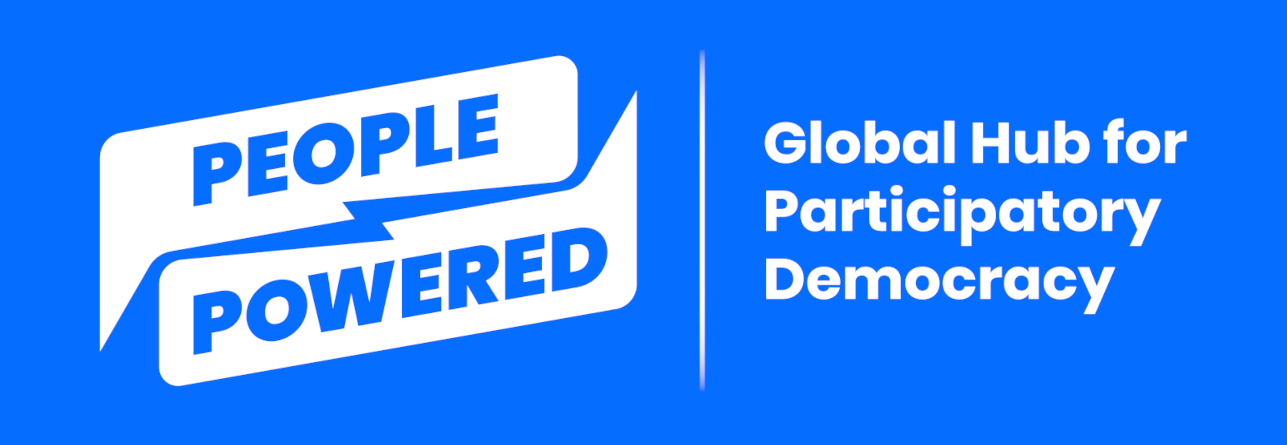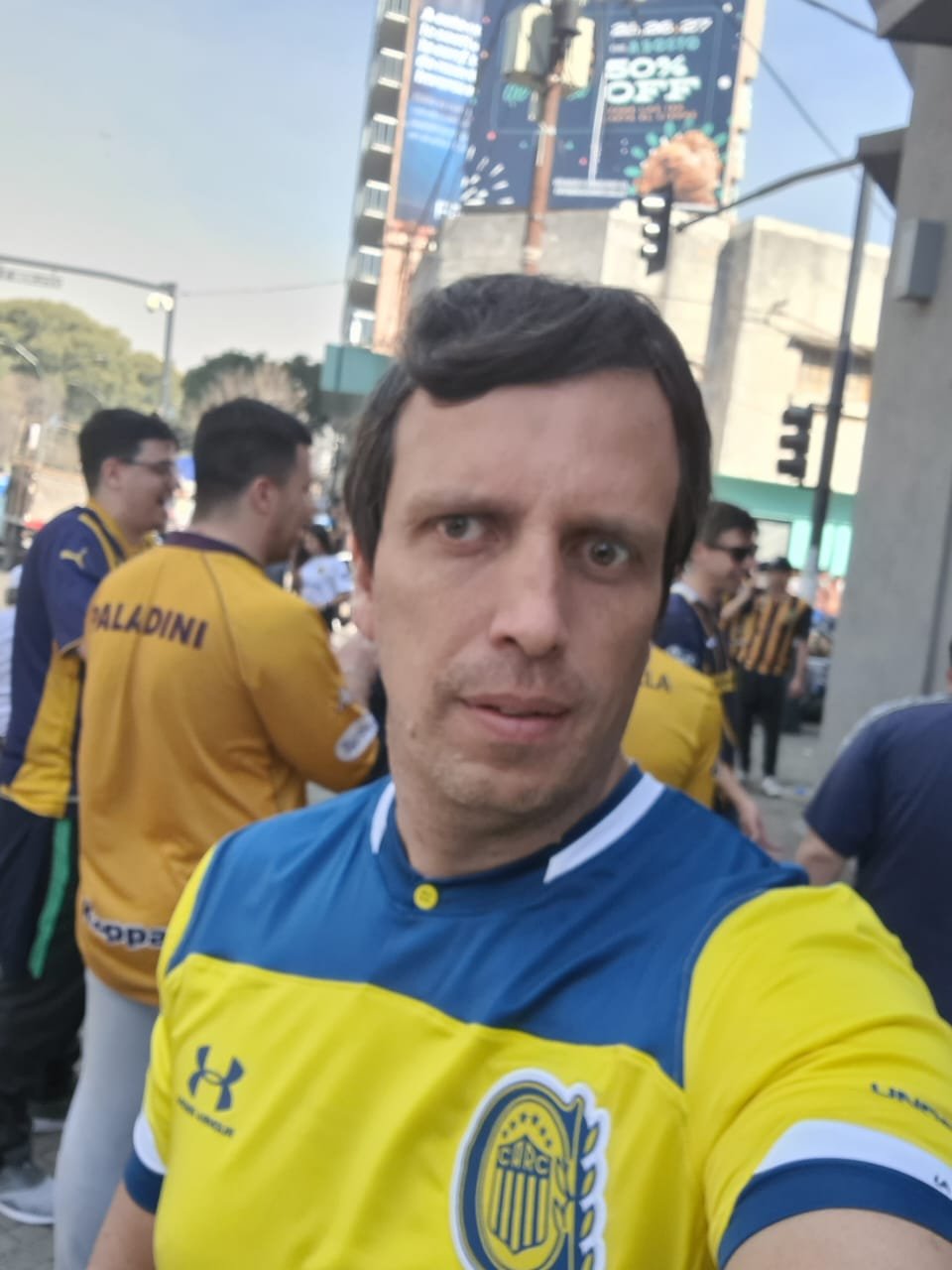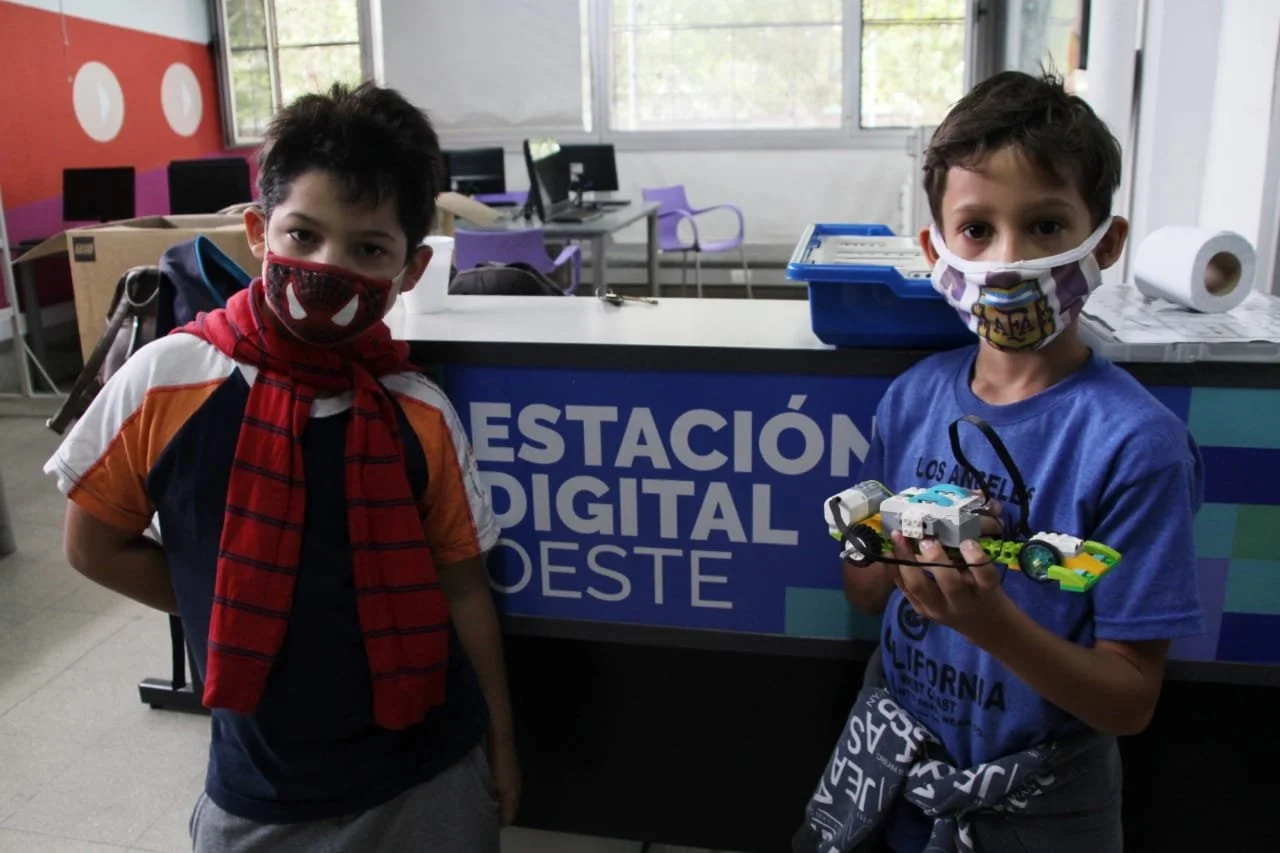Participation must be designed to ‘leave no one behind’: Argentina case study
/At this digital station, everyone from seniors to children learn about the potential of online technology. In this case, children learn about robotics.
Argentina’s municipality of Rosario is so committed to “digital transformation” that it has integrated it into every aspect of its operations, from education to participatory budgeting. One aspect of the application of digital technology to participatory budgeting is a commitment to make the process totally accessible to individuals with visual disabilities. This post , part of a series of stories on digital participation platforms produced with the support of TICTeC, explains how to do that. To read others in the series, see these case studies from China, Kyrgyzstan and Chile.
Fernando is a fan of Rosario Central (one of the city’s two football teams). He always goes to the games even though he can't see them well.
One in every 10 residents of Argentina lives with an impairment in hearing, sight or mobility. And at the age of 11, Fernando Plenza became one of them. He developed a rare disease that robbed his right eye of its sight and narrowed the world seen out of his left to a small “donut hole.”
“I can navigate around town because I’m so familiar with it,” says Fernando, who grew up in Rosario, the country’s third-most populous city. “But so many things about daily life are challenging: reading street signs, deciding what to eat from a restaurant menu, and browsing websites.”
Fortunately, recognition of the burdens borne by persons with disabilities has grown exponentially in the last two decades, resulting in an explosion of technology, architectural design features, etc. that make daily life easier. And both businesses and governments have increasingly required their use. Argentina, for example, passed such a national law in 2010, followed by Rosario in 2016, requiring the city to provide information to people with disabilities about “mobility aids and assistive technologies, as well as related services."
It was Fernando’s goal to make sure the government fulfilled the spirit of the law by making every aspect of its operations “friendly” to people like him, particularly the many channels Rosario has developed to allow residents to participate in local governance. That goal became real when he joined city staff in 2015 as part of its mandated quota of employees with disabilities.
“To be genuine,” Fernando says, “participation must include everyone.”
Rosario’s tradition of public participation
“Our political system is very inclined toward the participation of the people,” explains Miguel Martín Cánaves, Rosario’s director of open government. “We see it as an opportunity to explain what the government's trying to do, to get citizens’ responses, and to improve our projects. We go to the people, we hear, we modify. By creating a channel of communication, when we need to go to the people and talk to them, they are predisposed to work with us. And for me, this is fundamental.”
Rosario has created and nurtured an entire “ecosystem” of participation, and will soon expand that into action related to the climate crisis. Miguel was accepted into the first cohort of the Climate Democracy Action program, a collaboration between People Powered, World Resources Institute and FIMA. Other elements of its participation culture are:
Neighborhood councils: These are permanent meeting spaces convened by the district directors, in which municipal officials and local residents, civil society organizations and the private sector come together to discuss issues related to their location or selected themes.
Citizen “acupuncture” laboratories: Issues and ideas surfaced by neighborhood councils are often delegated to these “labs,” where some of the same participants collaborate to develop and implement small-scale, highly focused, relatively inexpensive interventions. They tend to focus on issues related to social cohesion, inclusion and accessibility.
Participatory budgeting (PB). The practice was first introduced to the city in 2002, when a new mayor was elected. It was a success, and in 2016, officials enhanced the PB process by launching Rosario Participa, a portal designed to expand participation via online access.
The tagline for the portal reads, “Welcome to Rosario Participates: join in, participate, decide
-
What advantage does Rosario have in terms of creating participatory programs?
What are some of the forums the city has established to invite citizen participation?
Do you think you’d be able to create a similar participatory culture in your municipality? Why or why not?
“Internet penetration is high, mainly through smartphones,” says Miguel. “In low-income sectors, many do not have access to computers, unless they have netbooks they received a few years ago as part of a government program that gave computers to students and minorities. But smartphones are everywhere.”
However, in 2017 or so, engagement in PB began to steeply decline. The culprit: a large deficit and high inflation.
“In addition, there were problems with the execution of the PB process,” notes Miguel. “Fifty percent of the projects were delayed or not finished. For example, it took until 2020-21 to complete a project selected in 2017. So, people lost confidence in the municipality's ability to comply with the outcome of the PB process.” Rosario is not alone; this is one of the PB challenges faced by governments around the world.
Knowing when it’s time for a ‘reboot’
With the arrival of a new municipal administration in December 2019, a Secretariat of Modernization and Proximity was created to redesign the participation process to make it more efficient. That included a re-evaluation of which digital participation platform best matched Rosario’s evolving needs.
Miguel facilitating a meeting
“It was a must for the software to be open-source, with an established community of users behind it,” explains Miguel. “But we also desired more flexibility than we’d had previously. We needed the portal to be a centralized hub for all our participation activities. For example, we wanted residents to be able to go there to review our open government action plan and the activities of each neighborhood council.”
Three digital platforms were evaluated; the final choice was Decidim, which ranked second highest among the comprehensive online participation platforms evaluated by a team convened by People Powered. [A guide to their selection and use also was developed.] Decidim is in use in other Hispanic cities such as Barcelona, Spain, and Mexico City, offering lessons learned to Rosario’s technological infrastructure team.
Every step of the PB process was examined as well. To restore trust, says Miguel, the city worked to shorten the time from co-creation to implementation to no more than eight months.
However, then came the COVID pandemic. Although Rosario began using Decidim in December 2020, the money allocated to PB was redirected to health care, and the process came to a halt.
“It’s been two years, but we’ve learned a lot in the meantime,” says Miguel. “And this is the perfect time for a relaunch. 2022 is the 20th anniversary of PB in Rosario.”
-
What were some of roadblocks that caused the first iteration of PB to fail in Rosario?
Why did Rosario choose Decidim as its online participatory platform?
Are the same criteria important to you?
Expanding digital literacy
Meanwhile, other activities were launched to expand the reach of the platform and make the city’s operations more inclusive overall. Although internet penetration is high, digital literacy isn’t universal.
The city’s open government action plan, developed as part of Rosario’s acceptance into the Open Government Partnership’s local program, states, “We’ve observed that our social life is [now] completely immersed in a complex process of digital transformation. This has generated new ways of linking, of doing procedures, of establishing channels of participation…But this modernization must take place in a humane way, without anyone being left out.”
In 2021, Rosario set up what it calls digital stations in four of its six districts, and two more are following by the end of 2022. Among the activities are workshops for senior citizens that teach them about cyber security, smartphone functionality and social media. In addition, clubs for teenagers focus on experimenting with social media to discourage violence and the use of digital tools to produce podcasts. To help them explore competitive new careers, young people are also taught about virtual reality, game programming, robotics and 3-D printing.
Teaching in action at a digital station
Likewise, to allow residents to use Rosario Participa to seamlessly engage in all of the city’s services and programs without having to upload information multiple times, a universal “digital citizen profile” was enabled—created whenever someone registers.
-
What did the city of Rosario do to expand digital literacy among residents?
Do you know to what extent there is digital literacy among the population you serve, and how it could be expanded?
Assuring accessibility: Fernando’s contribution
The city of Rosario enshrines expanded protections for people with disabilities in a 2018 law that mandates the accessibility of municipal websites. And that’s where the city’s Directorate of Disability Services—and a team including Fernando—came in.
It is telling that when it was first established, the directorate was part of the Secretariat of Health. However, today it operates within the Secretariat for Modernization and Proximity—a sign of the city’s mainstreaming of issues related to accessibility. Thus, a team from the directorate was brought in soon after the development of the Decidim version of the portal to assess its user friendliness for this population.
Natalia Pelillo heads the accessibility team within the Directorate of Digital Transformation, and herself is motor-disabled due to a congenital malformation of her leg muscles. She is committed to what the city calls “digital transformation,” working with the wide variety of organizations in Rosario that serve disabled individuals to “demolish the barriers they encounter in their daily lives.”
Natalia, with Fernando at the forefront, thoroughly evaluated the online portal used for PB and other city functions and invited public consultation as well. The result was not only a more accessible portal for those with visual impairments or low vision, but also a guide that the various players in the city’s participation ecosystem can use. Among the most important tips Fernando says he would call out to others, based on his assessment of the new Rosario portal are:
Use a logical hierarchy of headings and subheadings, and tag (code) them appropriately. People who are blind or have vision impairments or learning disabilities rely on screen readers, software programs that render text displayed on the computer screen into speech (using a synthesizer) or braille. Headings communicate the proper organization of the content to the screen reader, and thus assist with navigation.
Embed “alt text” into every image, unless they are merely decorative. A good basic rule for how to write alt text is to imagine you’re reading the web page aloud over the phone to someone who needs to understand the main points. How would you describe what the image is designed to communicate?
Assure that there is adequate contrast between font and background colors, which is essential for those with low vision or color blindness. “This is actually important for the general public, since vision acuity erodes with age,” notes Fernando.
Ana Mosich, another web accessibility specialist on the team, adds that writing in language that is simple and concise is another tip that helps everyone.
“Improving accessibility of communication is a process that must be maintained on an ongoing basis,” says Ana. “The guide we just produced is ‘version 1.0.’ The idea is to keep it under regular and continuous revision and improvement, with more people with disabilities participating.”
-
What does the term “accessibility” mean in terms of website usability?
How did the Rosario government assure that its internal team had the necessary expertise to make its websites more accessible?
Do you know if your organization’s website is fully accessible?
Reaching everyone where they are
Of course, increasing inclusivity is not all about online access. “For some people, we still need in-person outreach. Just because a person knows how to use WhatsApp on their smartphone doesn't mean they can or want to use the Decidim platform. No one is going to engage with you, on or offline, if you don’t go looking for them, and extend an invitation,” says Miguel. “You have to interest them. We are like the owners of a shop who must attract people inside. And we do that mostly in person. We use district teams who know the territory, along with nongovernmental associations and clubs, which are very popular in Argentina.”
While voting is 100% digital, the outreach teams help people do so via tablets and smartphones. The voting process is led by citizen participation teams led by Macarena Raya (the municipality’s general coordinator for participation), who manages to maintain a constant presence at more than 120 voting points throughout the city.
The top two vote-getters in 2022 attracted more than 6,000 voters each. The Western District project (left) will improve a park. The Northwest District initiative will enhance three outdoor shopping centers.
So, how did the reboot of participatory budgeting go in 2022? Miguel describes the steps of the new process:
Collection of proposals for a “Bank of Ideas,” which can be submitted online or via neighborhood council meetings, city events, etc. (A map of collection points is shown on the portal.) In 2022, the total PB budget is an average of 1.2 billion pesos (US$8 million), which is divided up by six districts, weighted by need. For example, the North District where Miguel lives is second in the city in terms of quality of existing infrastructure, so it was allocated 180 million pesos. In contrast, the West District has more need for improvements and thus was given 212 million pesos. More than 8,000 residents participated and submitted 130 proposals. “This time we focused the call for ideas on infrastructure,” notes Miguel. “Because we had gone without PB for two years, we knew the city needed bigger-impact projects, like construction of new health care centers, refurbishing of city squares, etc.”
Analysis and “collaborative improvements” in the proposals through citizen acupuncture labs in each district. (Smaller projects are rolled into larger ones, adding up to about 80% of the budget allocated for the district, with the remainder reserved for improvements.)
Technical feasibility evaluation by a team of city professionals.
Voting, which in 2022 was held from July 11-29. Fifty-three projects were put to a vote. Each voter was allowed to choose three projects, with one leader selected per district. (However, worthy projects that can’t be funded from the PB fund are considered for financing via the general budget.) In 2022, 43,000 people voted.
Implementation.
“We’re in the implementation stage now, and we’re on track to complete the chosen projects in a timeframe that will restore the people’s trust,” says Miguel. And as for Fernando, he tracked the entire process and feels fulfilled: “I believe no one was left behind.”
Key lessons
Benefits of digital participation platforms
Capitalize on the ubiquity of smartphones.
Help streamline the project selection and implementation process.
How to use digital platforms effectively
Look for open-source options that allow maximum flexibility.
Make them easily accessible to persons with disabilities by testing them with individuals who have visual impairments.
Ready to explore further?
Watch our webinar and read our infosheet on designing PB programs to be disability-friendly.
Visit the People Powered Digital Participation Platform Guide and ratings.
Sign up for coaching by an experienced mentor.














